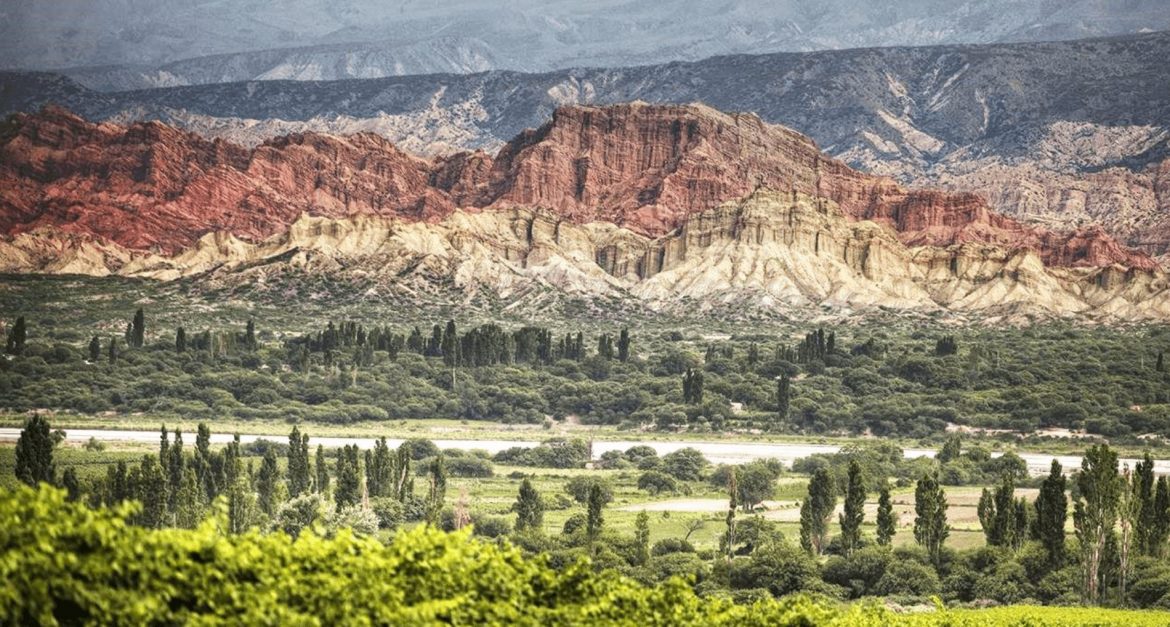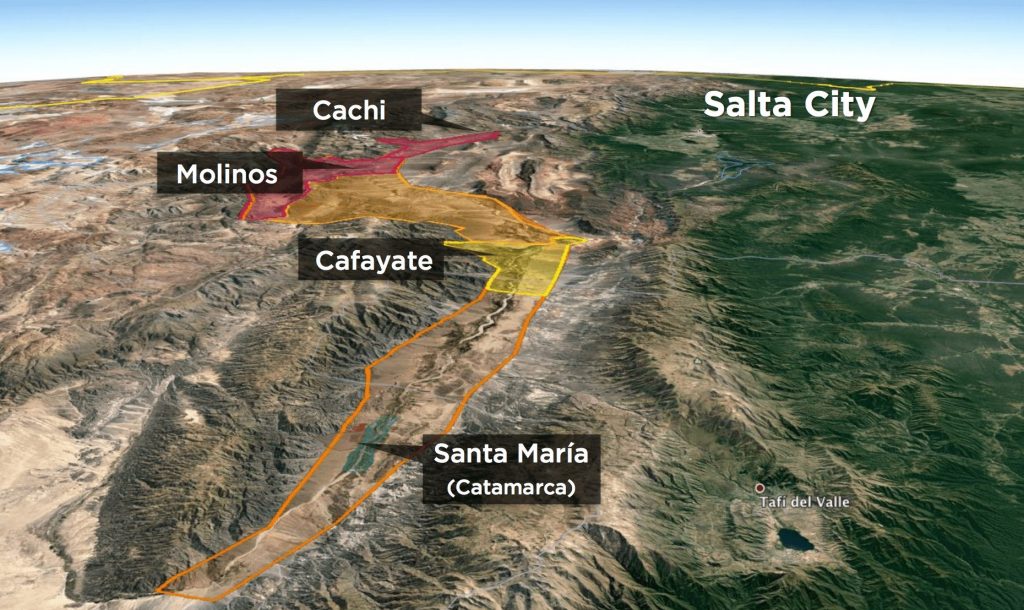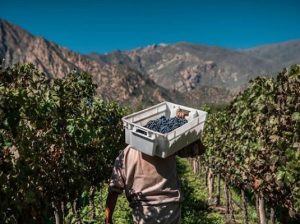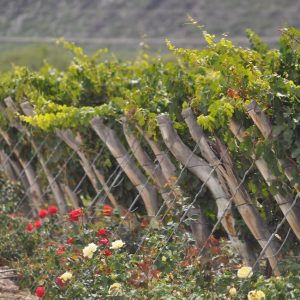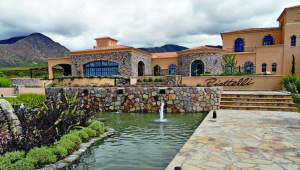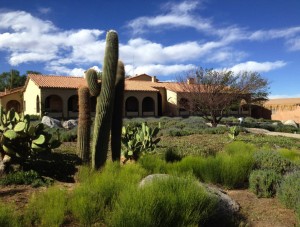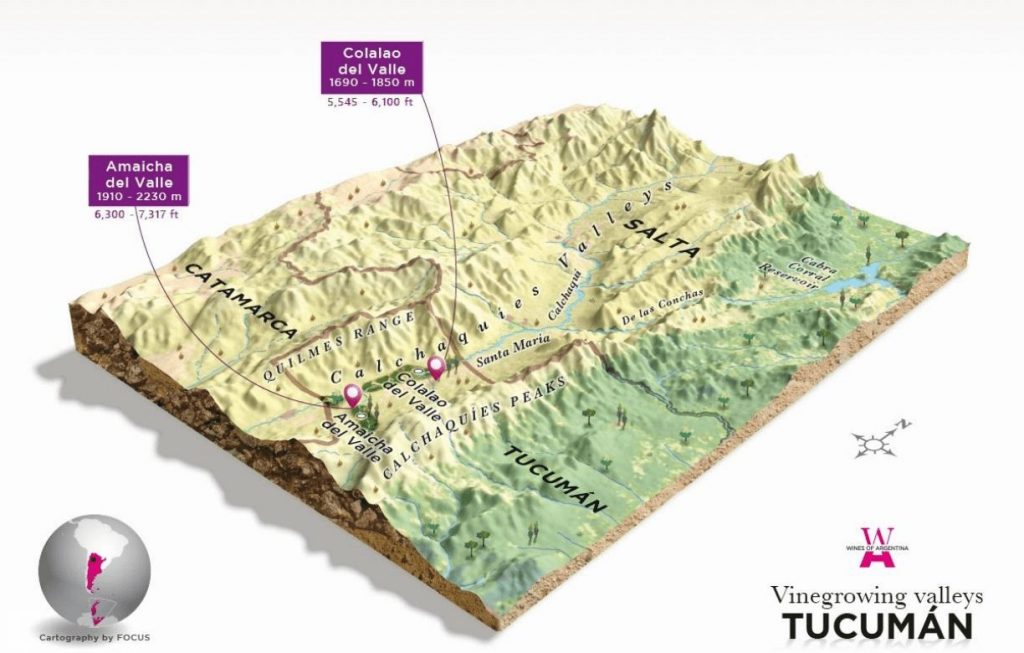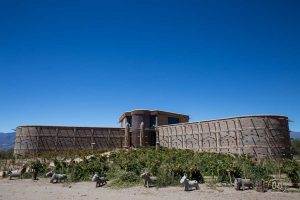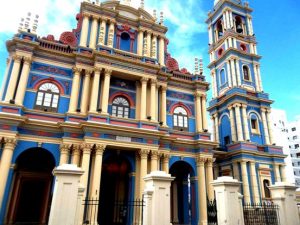The
It is in fact within the , in Cafayate in Salta, where you’ll find Argentina’s oldest recorded living vineyard
you are surrounded by colourful mountains and mineral-rich hillsides in either direction. The brightly coloured hillsides with their psychedelic hues of pink, purple, green and yellow are a tourist attraction in their own right, but also make quite a striking background for vineyard visits.
In the same way that the pinstriped hills alternate between different coloured mineral deposits, the soils of the are just as varied. Pockets of pebbles, rocks and limestone can be discovered in many vineyards, accompanied by well-draining sandy-loam soils.
Combine this poor soil with the incredibly dry weather and the enormous thermal amplitude, and you have a wine region that naturally produces low yields of healthy and concentrated grapes. The may only represent 2% of the country’s vineyards, but they claim a disproportionate share of Argentina’s wine awards due to the natural concentration, character and refreshing acidity of the wines.
Fact file on wine regions & wine guide to Salta, Tucumán & Catamarca
- First planted: Mid 1600s
- Hectares planted: 4,200 (3,370 hectares in Salta, 113 in Tucumán and 708 in Catamarca)
- No wineries/vineyards: Over 450 vineyards
- Average vineyard size & production size:
- Regions & sub-regions:
- Latitude: 26.07°S (Cafayate)
- Longitude: 65.97 °W (Cafayate)
- Altitude: 1530m to 3111 metres
- Geological description:
- Soil formation & characteristics:
- Climate type and info:
- Avg. growing season day time: 27°C
- Avg. growing season night time: 15°C
- Diurnal range: 12°C
- Rainfall average (and when): 186 mm per year. Concentrated in the summer months.
- Adverse climate conditions:
- Most planted varieties: Malbec, Cabernet Sauvignon, Torrontés, Tannat, Merlot, Cereza, Syrah, Bonarda, Moscatel.
Useful resources on the wine regions of Argentina
Wine production in South America
- 3,370 hectares planted
- Salta sub-regions: Cafayate, Molinos, Cachi, San Carlos
Salta is just about the biggest wine-producing province in the north but not by a wide margin (Catamarca only has some 500 hectares less), although it punches above its weight in terms of reputation. Salta is likely the second province (following Mendoza) that wine drinkers will mention, even though it is the fourth in terms of production, and that is largely because of its importance in wine tourism and being the mecca for Argentina’s best-known native white variety, Torrontés.
It’s not just because Salta is best known for a white wine that it bucks the wine trend in Argentina, but Salta’s wine production is also growing! It is the biggest growing historic wine region in Argentina and its wines – both white and red – are becoming more widely appreciated worldwide. Over the last decade it has grown by 50% and well over 1,000 hectares, much of which has been planted with Malbec and Cabernet Sauvignon.
- 2,518 hectares planted
Cafayate is Salta’s biggest and most renowned wine region, and certainly the best known and biggest in the
Cafayate town is about 1700 metres above sea level and its vineyards surround the town, reaching some higher altitudes well over the 2000 metre mark. Cafayate is on the southern end of Salta province, right below San Carlos sub-region, and about 100km from the higher-altitude and northern-most Salta sub-regions of Molinos and Cachi.
There are many wineries and vineyards based in Cafayate and it has a booming wine tourism which is comparable to Mendoza in its earlier days. The town of Cafayate is still quaint with a laidback and authentic charm, making this a beautiful wine region to explore over a few days.
Key producers & wineries in Cafayate
Amalaya
Good value wines from Cafayate made by the Amalaya winery, owned by Swiss multimillionaire Donald Hess (Hess Collection Family Wine Estates with wineries in California and Argentina). Read more about Amalaya in our winery guide.
Bodega Altupalka
Despite its name, Bodega Altupalka does not have its own winery. It does, however, have two vineyards: one in Cafayate (9 hectares) and one in Molinos (11 hectares). Read more about Bodega Altupalka in our winery guide.
Michel Torino (El Esteco)
Michel Torino (El Esteco) winery was originally established by a French-Italian family back in 1892. Today the winery is owned by the Peñaflor Group and the premium brand of their portfolio is El Esteco which includes some fantastic old vine wines. Read more about Michel Torino (El Esteco) in our winery guide.
 Viñas en Flor winery
Viñas en Flor winery
Viñas en Flor winery in Cafayate produces a range of single varietal wines, such as Cabernet Sauvignon, Malbec and Torrontés. The winemaker, Jose Luis Mounier, is one of the most renowned oenologists in Cafayate. Read more about Viñas en Flor in our winery guide.
Bodegas Etchart Cafayate
Bodegas Etchart is a large producer of good value wines from high altitude vineyards at nearly 1,800 metres above sea level. Etchart is one of the principal producers of Torrontés and their late harvest sweet Torrontés is one of their most popular wines. Read more about Bodegas Etchart Cafayate in our winery guide.
San Pedro de Yacochuya
San Pedro de Yacochuya is the joint project of star Bordeaux winemaker Michel Rolland and the Etchart family in Cafayate valley. The winery is open for tours and tastings of their Torrontes, Cabernet Sauvignon and Malbec. Read more about San Pedro de Yacochuya in our winery guide.
Finca Quara
Finca Quara is a family winery which is currently run by the fourth and fifth generations of the Lavaque family. The winery produces good value wines from their vineyards in Cafayate which are situated at an altitude of 1,600 to 2,000 metres above sea level. Read more about Finca Quara in our winery guide.
El Porvenir de Cafayate
El Porvenir de Cafayate is an antique bodega in the centre of Cafayate. Consultant winemaker Paul Hobbs, along with the Head Winemaker Paco Puga and Head Agronomist Daniel Guillén make a strong team producing premium wines. Read more about El Porvenir de Cafayate in our winery guide.
Pia ttelli Cafayate
ttelli Cafayate
The Piattelli family from the US have two wineries in Argentina, one in Cafayate and one in Mendoza. Their Cafayate winery has a great restaurant and produces Torrontes, Malbec, Cabernet Sauvignon and Tannat. Read more about Piattelli Cafyate in our winery guide.
Las Arcas de Tolombón (Siete Vacas)
Las Arcas de Tolombón (Siete Vacas) has three different vineyard estates in Cafayate and Colalao del Valle (Tucumán). The winery is best known for its Siete Vacas single-varietal line.
Estancia Los Cardones
Estancia Los Cardones is a relatively new enterprise which planted its first vineyards in 2009, 8 years before the winery was built. Nonetheless, the winery has an expertise portfolio on offer and you can taste their wines during your visit to the winery or your stay in the estancia.
Agustín Lanús Wines (Bad Brothers)
Bad Brothers wine is the joint project of Argentine sommelier Agustín Lanús and his friend and business partner, David Galland. This winery based in Cafayate produces wines from a series of different vineyards in the area situated in Cafayate, Santa María, Amaicha del Valle, Pucará and Luracatao.
Tukma
Fernando Maurette and Raúl Noceti started off their small business by investing in a small vineyard in Huacalera, Jujuy. They have since acquired a 49-hectare estate in Tolombón, in the Cafayate department, as well as another 3 hectares in Angastaco.
Cachi wine region guide (Salta)
- 87 hectares
Cachi is the smallest of Salta’s wine regions but it is also the highest, with vineyards scaling up to 3,111 metres altitude. Cachi is also the northernmost region in the Calchaquí Valley at the northern tip – just above Molinos.
Key producers & wineries in Cachi
Miraluna
Miraluna winery and vineyards solely produces red wines and its portfolio includes single varietals of Malbec and Merlot. You can rent one of the winery’s cosy cabañas which are surrounded by the vineyards. Read more about Miraluna in our winery guide.
Molinos wine region guide (Salta)
- 130 hectares
Molinos sub-region in Salta is just below Cachi in the northernmost tip of the Calcahquí Valleys. Gravel, sandy and volcanic soils combined with the dry climate and high altitude give Molinos wines great concentration and character.
Key producers & wineries in Molinos
 Bodega Colomé
Bodega Colomé
Bodega Colomé is one of the highest altitude wineries in the world situated in the Upper Calchaquí Valley ranging from 2,300 and 3,111 metres above sea level. Bodega Colomé is currently owned by the Hess family. Read more about Bodega Colomé in our winery guide.
Bodega Altupalka
Despite its name, Bodega Altupalka does not have its own winery. It does, however, have two vineyards: one in Cafayate (9 hectares) and one in Molinos (11 hectares). Read more about Bodega Altupalka in our winery guide.
San Carlos wine region guide (Salta)
- 625 hectares
San Carlos is the second-largest sub-region of Salta and is just tucked above Cafayate, but is a bit lower in altitude (only reaching up to 1905 metres above sea level). It is also popular on the wine tourism route (being so close to Cafayate) and you’ll find boutique hotels and lots of artisan craft stalls in San Carlos.
Key producers & wineries in San Carlos
Tukma
Tukma winery has a vineyard in San Carlos as well as other regions in the Calchaquí Valleys.
Tucumán wine region guide (Amaicha del Valle & Colalao del Valle in Tafí del Valle)
- 113 hectares planted
- Tucumán sub-regions: Amaicha del Valle, Colalao del Valle
Tucumán is one of Argentina’s smallest provinces and its wine production is just as boutique, with 113 hectares planted to date. With the Tucumán wine regions started just 30km from Cafayate, the rise of viticulture here has been quite rapid, considering that at the beginning of the 90s there were barely a dozen hectares of vines planted.
The wine regions of Tucumán are within the Tafí del Valle region, which can be split into two sub-regions: Amaicha del Valle and Colalao del Valle. With just 30km distance between them, Colalao del Valle sits just north of Amaiche del Valle and both wine regions straddle the Santa María river.
The vineyards here share very similar characteristics with those in Salta: generally high altitude (between1,690 to 2,230 metres above sea-level), a very low rainfall (just 100mm per year) and a wide thermal amplitude. Malbec is King here (constituting 40% of plantings), followed by Cabernet Sauvignon and Torrontés (which each represent about 17% of plantings).
Key producers and wineries in Tucumán
 Las Arcas de Tolombón (Siete Vacas)
Las Arcas de Tolombón (Siete Vacas)
Las Arcas de Tolombón (Siete Vacas) has three different vineyard estates in Cafayate and Colalao del Valle (Tucumán). Read more about Las Arcas de Tolombón (Siete Vacas) in our winery guide.
Tukma
Tukma winery also has vineyards in Tucumán which go into their diverse portfolio.
Catamarca & Santa María wine region guide
- 747 hectares planted in Calchaquí Valley
- Catamarca sub-regions in Calchaquí Valley: Santa María
Catamarca as a province has over 2,800 hectares of vines planted, however, it is only the 750-odd hectares planted in the northern sub-region of Santa María which fall within the Calchaquí Valleys. Although Santa María only represents a quarter of Catamarca’s vineyards, it is the second-largest sub-region in the Calchaquí Valley, following Cafayate.
Just 20km from Amaicha del Valle in Tucumán, Santa María shares very similar characteristics as the other Calchaquí sub-regions in Tucumán and also Salta. The Santa María river ends here (extending up to Tucumán’s Colalao del Valle region) and this zone is also the end of the Calcahquí mountain range.
Santa María as a wine region has also boomed significantly since the 90s, growing from 184 hectares in 1990 to 747 hectares in 2018. The increased interest in Santa María and this southernmost point of the Calchaquí Valley has been largely driven by its excellent quality red wines (mainly Malbec and Cabernet Sauvignon) and its perfumed Torrontés.
Key producers and wineries in Santa María in Catamarca
Agustín Lanús Wines (Bad Brothers)
See Bad Brothers wine in Cafayate.
Video guides on Calchaquí wine regions
A taste of Cafayate, its Torrontés & wine pairings from Salta
Torrontés, empanadas and a siesta are three fundamental pillars in life in Cafayate for Lucía Romero, whose family own El Porvenir winery in the Salta province in northern Argentina. Amanda Barnes interviews her about what the key is to the famous Argentine Torrontés wine variety from this region as well as the flavours, aromas and taste of Torrontés. They talk about the best wine pairings and about the lifestyle that comes with experiencing this quaint and beautiful part of the world.
How to make classic empanadas from Salta (& wine pairings!)
Get the full recipe, method and technique behind making Argentina’s classic empanadas salteñas. Amanda Barnes meets up with chef Gabriel Rodríguez at Piattelli in Cafayate to learn the secrets, the ingredients and the top pairing for proper empanadas.
Travel highlights from the Calchaquí Valleys
The Calchaquí Valleys are a fantastic destination to visit in Argentina not only for their vinous treasures but also for cultural riches and stunning landscapes.
The town of Cafayate is a highlight with its vibrant yet relaxed atmosphere and charming hotels, restaurants and bars. The Museo de la Vid y del Vino (Museum of Vines and Wine) is also a highlight in Cafayate, for its viticultural exhibition which explains the different stages of growth of the vines through a collection of poems and pictures. Nearby the red rock mountains of Quebrada de las Conchas and the route along the Rio Colorado with its series of waterfalls are popular for bike rides and treks.
If you are interested in architecture, then you should make Salta a destination en route to the Calchaquí Valleys. Renowned for its beautiful colonial architecture and churches, one of the most famous is the colourful Iglesia Nuestra Señora de la Candelaria de la Viña. In 1630, the owners of the La Viña ranch decided to build a chapel in honour of the picture of Nuestra Señora de la Candelaria which had been brought over all the way from Coimbra in Portugal. In 1735, they finally managed to put the picture up but the religious shrine was almost in ruins at the end of the century and they had to rebuild the church in 1873 with a replica of the picture of Nuestra Señora de la Candelaria.
Salta is also home to a series of great museums, one of the most famous of which is the High-mountain archaeological museum (MAAM). The museum was founded after three mummies of Inca children were discovered on the Llullaillaco, the highest active volcano on the planet. The mummies are in an almost-pristine state as they were preserved by the icy cold temperatures at altitude for half a century without ever having been mummified. Each mummy is exhibited for 6 months and they are rotated so that they are not damaged.
Another museum worth visiting in Salta is the Museo Pajcha Arte Etnico, which displays an extensive collection of indigenous art from different South American communities. The museum contrasts older pieces alongside more contemporary works so that visitors can see how the artistic style has developed.
